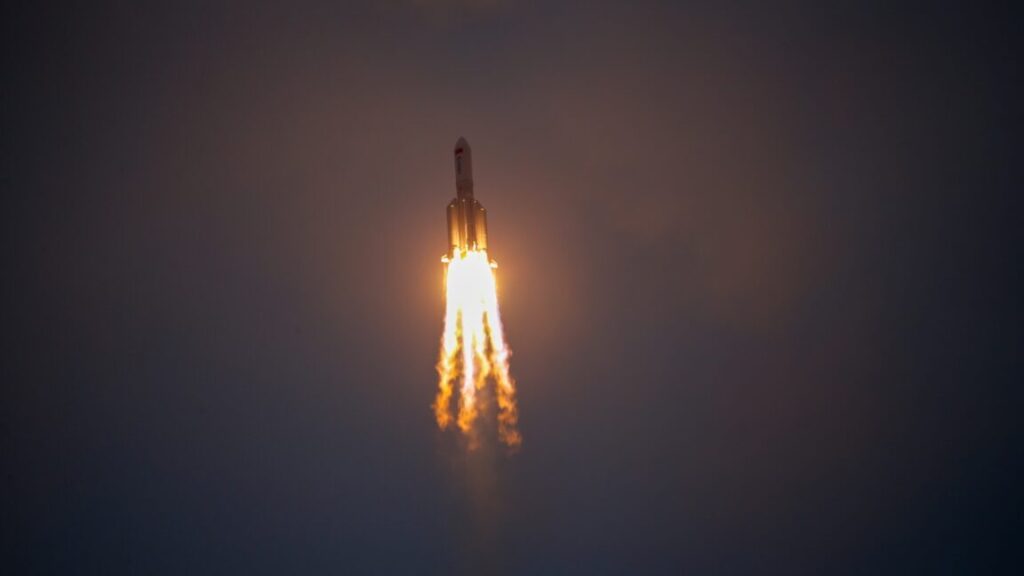
While there are open questions about how China will use its satellite megaconstellations, their deployment will require a significant increase in the country’s launch capacity, driving the development of new commercial rockets, including reusable boosters, to lower costs and increase their flight rate.
The Long March 5B rocket, developed by China’s incumbent state-owned launch company, is not the most cost-effective of these options. But the Long March 5B has the lift capacity to haul more Guowang satellites to orbit than any other operational Chinese rocket. It’s likely future satellites for Chinese megaconstellations will fly on multiple types of rockets as more launchers come online.
China has until 2032 to launch half of the Guowang constellation—6,496 satellites—according to radio spectrum regulations promulgated by the International Telecommunication Union.
A watchful eye
The military implications for Chinese networks like Guowang and Qianfan aren’t lost on US Space Force leaders. Large megaconstellations like Starlink, or the future Amazon Kuiper and Guowang systems, have the advantage of being difficult to disable or destroy, compared to a single large communications satellite providing wide-area coverage.
“This just is a continuation of what China’s been doing now for about 20 years,” said Gen. Stephen Whiting, the top general at US Space Command. “In addition to all the counter-space weapons they’ve built, they are building capability to enable their army, their navy, their air force, their marines, to be more lethal, more precise, and more far-ranging.”
“We’ve seen hundreds of (surveillance) satellites, and now it seems like they’re launching this proliferated, low-Earth orbit constellation to give them global communications to enable their operations on a broader scale,” Whiting said. “Certainly, it’s something we’ll be watching to see how that develops. But it’s just a continuation of the breathtaking speed at which they’ve been they’ve been moving in space.”
Brig. Gen. Anthony Mastalir, commander of US Space Forces in the Indo-Pacific region, said he is most interested in seeing how China integrates constellations like Guowang into their military operations. China is conducting increasingly “elaborate and complex” military exercises, Mastalir said, and US commanders will assess if, and how, China incorporates the global communications capabilities of Guowang into future exercises.
“Seeing how they integrate space across that exercise regime is something that we’ll be watching very closely in terms of assessing the relative success of their megaconstellation,” Mastalir said.
Credit:
Eric R. Dietrich/US Space Force
In response to questions from Ars at last week’s Spacepower Conference in Orlando, Florida, Whiting said Space Command will track the deployment of the Chinese satellite constellations, just as they do other fleets, like Starlink. The difference is SpaceX, with more than 6,800 Starlink satellites currently in orbit, sends information on its launch schedules and spacecraft positions to Space Command, essentially giving the military a heads-up to know where to look as they track orbital traffic. China does not do the same for its satellites.
Space Command currently monitors around 47,000 objects in orbit, and screens them for risks of collisions. If there’s going to be a close encounter between two active satellites, Space Command informs their operators.
“When we see that there’s going to be what we call a conjunction, we send that information off, and we continue to do that with China,” Whiting said. “We do not get regular communications back. There have been a couple times over the last year where they reached out through various ways to give us heads-up about some things going on in space, like a satellite re-entering, but that is not a routine, standardized way of communication.”
Whiting said he’s not worried about the safety of so many megaconstellations coexisting in low-Earth orbit, provided their operators “follow tenants of responsible behavior.”
“We want to make sure that folks are doing all the right things with prediction, predictive conjunctions, and then not leaving debris in orbit, and all those kind of things,” Whiting said.
But, still, Whiting said it would be helpful for Space Command to have a regular dialogue with China.
“We think there should be a way to have space safety discussions,” he said.